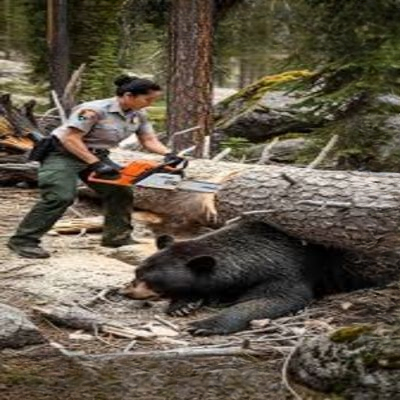When hikers reported eerie growls echoing through a remote stretch of pine forest, many immediately assumed that a wild predator was nearby. Some feared they had wandered too close to a territorial bear or another large animal, poised to defend its territory.
What they discovered, however, was far more startling—and far more poignant. A massive black bear lay trapped beneath a fallen tree, struggling to survive. What could have ended in tragedy became a breathtaking story of courage, compassion, and the delicate bond between humans and the natural world.
A Scene of Tension and Compassion
Deep within the untamed wilderness, where ancient pines tower over quiet trails and the air hums with the subtle music of unseen wildlife, a remarkable rescue unfolded. Guided not by fear or brute force, but by empathy, skill, and determination, a park ranger confronted a situation that would test both physical and emotional resilience: freeing a black bear pinned under a crushing trunk.
The rescue began when hikers, startled by unsettling growls, called for help. Following the sound, the ranger discovered the bear’s plight: its powerful frame immobilized, trapped under a massive fallen tree. Despite the animal’s natural strength, the weight of the trunk left it helpless. Its shallow, labored breathing and strained movements revealed the gravity of its condition—without immediate intervention, the bear would not survive.
Instead of seeing the animal as a threat, the ranger saw a life in peril. Equipped with a chainsaw, the ranger began the painstaking work of carefully cutting through the trunk. Every movement required precision: a miscalculation or excess vibration could worsen the bear’s injuries, while the roar of the chainsaw risked further distressing it. Yet through steady hands, patience, and unwavering focus, the ranger worked to give the bear a second chance at life.
Understanding Black Bears: Behavior and Habitat
To appreciate the full magnitude of this rescue, it helps to understand the creatures involved. Black bears (Ursus americanus) are among North America’s most widespread large mammals, inhabiting forests, mountains, and swamps across the continent. Despite their reputation as formidable predators, black bears are generally solitary, elusive, and more likely to avoid humans than confront them.
Bears play a crucial role in ecosystems. As omnivores, they help control insect populations, disperse seeds, and maintain forest health. Their presence indicates a balanced, thriving environment. Yet their natural habitats are increasingly threatened by human expansion, road construction, and deforestation. Encounters between humans and bears, while relatively rare, require caution, respect, and awareness of the animal’s behavior.
Black bears are also physically strong and agile. An adult male can weigh between 200 and 600 pounds, while females range from 150 to 400 pounds. Despite their size, even a strong bear is vulnerable when immobilized or trapped. The situation faced by the ranger was extraordinary because the bear’s natural strength could not compensate for the crushing weight of the fallen tree.
The Rescue: Step by Step
Those who witnessed the rescue describe it as tense and unforgettable. The air was thick with anticipation: the low, guttural sound of the bear’s breathing, the relentless buzz of the chainsaw, and the silent focus of the ranger working methodically against time.
-
Assessment: Before taking action, the ranger evaluated the bear’s position. Ensuring that the bear could not accidentally shift and worsen its injuries was critical. A misjudgment could have been fatal for both the animal and the rescuer.
-
Stabilization: Using ropes and carefully positioned supports, the ranger stabilized the tree to prevent sudden movement during cutting. This step required an understanding of physics, animal behavior, and improvisational problem-solving under pressure.
-
Cutting: With a chainsaw in hand, the ranger made precise cuts through the trunk. The roar of the saw was deafening, yet the ranger maintained focus, balancing speed with caution. Each cut had to be deliberate to avoid shaking the trunk excessively or causing splinters that might injure the bear.
-
Monitoring: Throughout the process, the ranger monitored the bear’s breathing, body position, and stress level. Small cues—a shift of its paw, a flicker of the eyes—indicated whether the bear was too stressed or in pain, requiring pauses to avoid further harm.
-
Liberation: After what seemed like an eternity, the final cut was made. The massive log rolled free. The bear, exhausted but alive, struggled to stand. Its pause—a silent, fleeting glance at the ranger—was a profound moment of recognition and connection before it disappeared into the forest.
Witnesses described the encounter as surreal. A creature of immense power, once helpless, returned to freedom thanks to human courage, skill, and empathy.
Park Rangers: Guardians of the Wild
This extraordinary incident highlights the vital role of park rangers. Beyond routine duties such as patrolling trails, preventing wildfires, and guiding visitors, rangers serve as the silent guardians of wildlife and ecosystems. Their responsibilities often extend into life-or-death scenarios, where human intervention can determine survival.
Park rangers receive extensive training to handle wildlife emergencies, including:
-
Animal behavior assessment: Understanding signs of stress, aggression, or vulnerability.
-
Safe handling techniques: Using equipment like ropes, chainsaws, and immobilization tools without causing harm.
-
Emergency medical support: Administering first aid to animals in distress.
-
Coordination with authorities: Engaging wildlife experts or veterinarians when situations exceed personal capacity.
Moments like the bear rescue reflect the deeper purpose of these roles: protecting life in all its forms, even when personal risk is high. The ranger’s actions illustrate that true strength is measured not by dominance over nature, but by empathy, patience, and courage.
